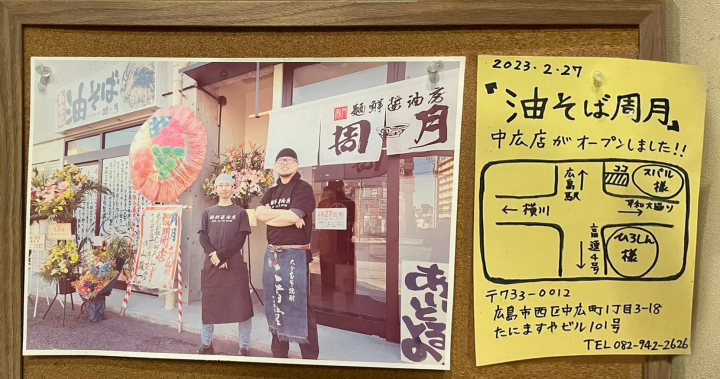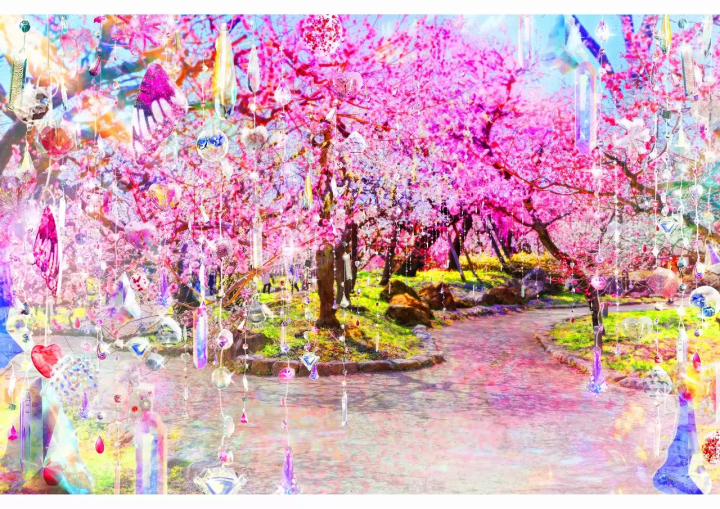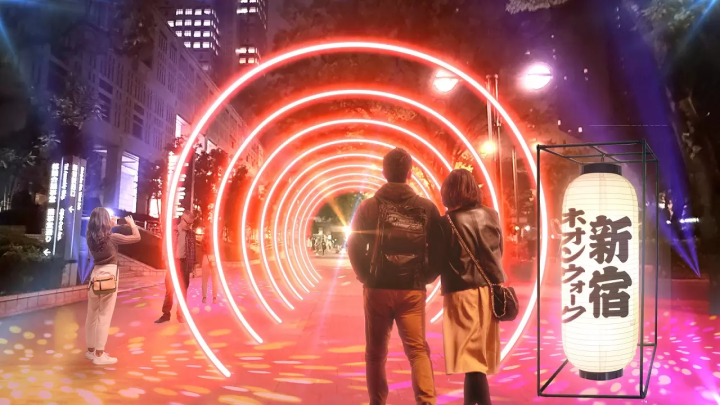Shugetsu's recommended dish is "tsukesoba," which is different from both Hiroshima and Kanto styles.

"Mensen Shoyubo Shugetsu" is run by a shop owner who was fascinated by Shuichi's ramen. The tsukesoba, which features homemade noodles and soup without umami seasonings, has a different taste from those in Hiroshima and the Kanto region. It is a nice service that they offer homemade noodles from regular to extra large at the same price.
-
Table of Contents
- What is Mensen Shoyubo Shugetsu?
- Directions to Mensen Shoyubo Shugetsu Hiroshima Takanobashi Branch
- Shugetsu's Commitment
- The owner's recommendation is this! "Tsukesoba"
- Besides tsukesoba, they also have abura soba and ramen.
- Ordering Method and Manners
- A word from the owners: Satoshi Matsuda and Yorinao Saeki
What is Mensen Shoyubo Shugetsu?
Mensen Shoyubo Shugetsu was established on December 27, 2008 as a branch of Shuhei, a famous restaurant in Matsuyama where the chef trained. The chefs there inherited the tradition of adding "Shu" to their names, and took the kanji character for "moon" from the character for "Shu" of the owner, Matsuda Satoshi, to create the name Shugetsu. The origin of the name comes from the idea that "the moon does not emit its own light, but receives light from the sun," and the chefs feel a sense of gratitude that they are not shining on their own, but that they shine thanks to the support of everyone around them, including their customers, suppliers, and seniors.
Matsuda, who started the ramen shop, felt that he had reached his limit of success running it alone, so he invited Saeki, the owner with whom he had worked while he was a salaryman, to join the business. As co-owners, the two of them worked together to spread Shugetsu ramen to the world.

Directions to Mensen Shoyubo Shugetsu Hiroshima Takanobashi Branch
8 minutes by car from JR Hiroshima Station . Take Hiroshima Electric Railway Line 1 (bound for Hiroshima Port) from JR Hiroshima Station to Takanobashi Station ( 13 stops , approx. 23 minutes ), get off and walk for a short distance. Take the Kannon Marina Hop bus from JR Hiroshima Station to Otemachi 4-chome (9 stops, 18 minutes ), get off and walk for approx. 3 minutes .

Attractions near Mensen Shoyubo Shugetsu
Nearby are the Atomic Bomb Dome and Peace Memorial Park.
Shugetsu's Commitment
Shugetsu's biggest concern is the technique of bringing out the umami flavor without using umami seasonings. He was attracted to Shuichi Ramen and wanted to share its taste, so he learned it from his master, Shuhei. It is said that he didn't need umami seasonings because he was particular about the ingredients and made the most of them.
Shugetsu's specialty is putting a lot of thought into each bowl of rice.

The owner's recommendation is this! "Tsukesoba"
"Tsukesoba" is said to be popular for its lingering deliciousness.
You can really tell when you eat it, but the dipping sauce has a strong "sea" flavor. It's a delicious broth with a strong flavor from dried sardines and seafood stock.

What is Tsukesoba?
It is also called tsukemen, but at Shugetsu we call it "tsukesoba."
This is a type of ramen in which the noodles and soup are served on separate plates, and is characterized by the style in which the noodles are eaten by dipping them in the soup.
①The noodles are thick and chewy. They are usually served cold, but you can also request hot noodles.
First, eat it as is and savor the flavor and texture of the wheat in the noodles themselves.
②The soup (dipping sauce) is soy sauce based, and Shugetsu serves a hot soup that has a Japanese-style stock feel.
③The ingredients are in the soup. If it comes with a seasoned egg, it is served next to the noodles as shown in the picture.
The unique feature of tsukesoba is that the noodles are not submerged in the soup, so you can enjoy the chewy texture until the very end. Also, if you dip the noodles in the soup, the noodles will get tangled up in the soup, allowing you to enjoy a deep flavor every time you eat it. You can also enjoy adjusting the flavor to your liking by adding chili pepper, black pepper, or vinegar.
This is a must-try product for ramen lovers, and for anyone wanting to learn more about Japanese noodle culture.
Shugetsu's commitment to the soup of tsukesoba
Hiroshima tsukemen is known for its sweet, sour and spicy soup, while Kanto-style tsukemen is known for its thick soup with animal and seafood flavors. This soup is neither of these, but is made with a stock based on dried sardines from the Seto Inland Sea, dried mackerel from Kumamoto Prefecture, and Maori kelp from Ehime Prefecture, and is seasoned with raw soy sauce from Kajita Shoten in Ozu, Ehime Prefecture. It is accented with a little vinegar, and even more unusually, it uses scallop oil. The moment you take a sip of this soup, the umami flavors of the various ingredients hit you right in the head, spreading out so much that they burst out. I think Shugetsu's ultimate technique is to combine natural umami flavors without using any umami seasonings to bring out the maximum umami flavor.
Another distinctive feature of Shugetsu is that, unlike regular tsukemen restaurants, the soup is not diluted with stock, but rather with the soup used for the ramen, allowing you to drink it down with a completely different flavor.

Attention to detail in noodles
The noodles are homemade, made without any preservatives, and are medium-thick with a strong wheat flavor. The noodles are left to rest overnight before being served, giving them a strong flavor that blends well with the soup without being too overpowering.

Another feature of Shugetsu is that you can choose the amount of noodles you want for their delicious homemade noodles, from regular to extra large. This is probably one of the advantages of homemade noodles, but the fact that extra large noodles are free is rare nationwide and a very welcome service for customers. In other words, the amount of noodles is the same for regular = 200g, medium = 300g, large = 400g, and extra large = 500g. 300g seems to be the most popular, so beginners should aim for the medium size.

You can choose between " hiyamori " and " atsumori" noodles. Personally and the restaurant recommends the "hiyamori" noodles. If you want to enjoy the flavor and texture of the noodles, then "hiyamori" is the way to go, but if you don't want the soup to get lukewarm then "atsumori" is best. You can eat it warm, but the downside is that the noodles tend to stick together easily.

Every day, the noodles for the Takanobashi and Nakahiro stores are made in-house using flour specially made for Shugetsu.
Attention to ingredients
The ingredients used are made with great care by local producers, and the chefs are confident that the product, including the toppings, is of the highest quality, resulting in a well-balanced bowl overall.

Besides tsukesoba, they also have abura soba and ramen.
Next, we recommend you try Abura Soba . The noodles, char siu, green onions, bean sprouts, bamboo shoots, and fish powder are served in a bowl filled with a soy sauce sauce made from fragrant scallop oil and raw soy sauce. We recommend mixing the noodles until the oil and soy sauce are thoroughly mixed before eating. If you mix well, the flavor will penetrate the noodles evenly, allowing you to enjoy the noodles with just the right amount of saltiness. The key is to "mix well!" If you like strong flavors, you can make the flavor stronger with the soy sauce on the table, or add vinegar to make it mellower, which will change the flavor and make it more fun. Abura Soba does not have a system for adding more noodles, so we recommend mixing the remaining ingredients and sauce with the rice at the end and eating it.
For those who prefer soup, we also have " ramen ". The soup is a clear soup made from chicken bones with a little aromatic vegetables, to which dried sardines and mackerel flakes are added for a punchy soup . The seasoning itself is the same, but the flavor is completely different. The noodles are thin, firm noodles of the Hakata style made for ramen.

Ordering Method and Manners
Here we will introduce how to order and proper etiquette.
At Shugetsu , customers are asked to sign in and wait in the order they arrive .
First, please fill out the waiting sheet with your name and the number of people , purchase a meal ticket in advance , and wait in front of the store. We will call you when it is your turn. Please note that the order may change depending on the number of people.

How to line up and points to note
When there is a line in front of a store, you will have to wait in line. There are a few things to keep in mind when doing so.
1. Line up once everyone is present.
2. Don't interrupt.
3. Wait outside the store.
4. Do not block the entrances of other shops or homes.
5. Don’t spread out too much on the road.
Please follow the rules so that everyone can have a good time.
How to order
There are two main ways to order at ramen restaurants in Japan: buying a ticket from a ticket vending machine, or looking at the menu and ordering verbally.
Please purchase your meal ticket first. Payment method is cash only .
After purchasing a meal ticket from the ticket machine , you will be shown to a seat, so please take a seat.
A staff member will come to your table and confirm your order.

A word from the owners: Satoshi Matsuda and Yorinao Saeki
We are confident that Japanese ingredients can be used worldwide.
What we offer is only a small part of it, but we hope that this opportunity will pique your interest in Japanese food culture.

Business hours and holidays
[Business hours] 11:00-15:00 (last orders 14:55), 17:30-22:00 (last orders 21:30)
[Store closed day] Sunday [Location] 1F Rocco Takanobashi Grand Mansion, 2-4-12 Kokutaiji-cho, Naka-ku, Hiroshima City, Hiroshima Prefecture
Introducing our affiliated stores
★ Aburasoba Shugetsu Nakahiro Branch [Business hours] 11:00-15:30, 18:00-21:00 (LO 20:50)
[Store closed days] None [Location] 1-3-18 Nakahirocho, Nishi-ku, Hiroshima City

"I want to spread the culture of women being able to eat ramen alone." With that thought in mind, she started eating out 20 years ago. She is a ramen-loving woman who has traveled to all 47 prefectures and eats more than 600 bowls a year. While there are many male ramen freaks, she is also known for her ramen life, which includes working as a TV personality and maintaining her figure. She organized "Ramen Girls' Gathering," renting out popular ramen shops, and in 2015 held the "1st Ramen Girls Expo" at the Yokohama Red Brick Warehouse. The event, which brings together popular shops from all over the country, was later held in Osaka, Nagoya, Tokyo, Kumamoto, and Shizuoka, attracting a total of approximately 750,000 people. In 2018, she founded Ramen Switch Co., Ltd. and released the world's first ramen jewelry brand, "ZURU+.". She produced and published "NOODLE SAKE -Spring, Autumn, Winter-" and "Rice and Agave Ramen-only Craft Sake," and "Tokyo Ramen Collection" (Shobunsha).
The contents on this page may partially contain automatic translation.




![[2025 Latest] How to get from Osaka to Hiroshima quickly and cheaply? How to get there by Shinkansen, bus, and car](https://resources.matcha-jp.com/resize/720x2000/2024/05/16-180184.webp)



























![[2026] Top 5 Strawberry Picking Spots in Tokushima, Naruto| Farms and Access Guide for January to May](https://resources.matcha-jp.com/resize/720x2000/2025/03/06-227165.webp)


